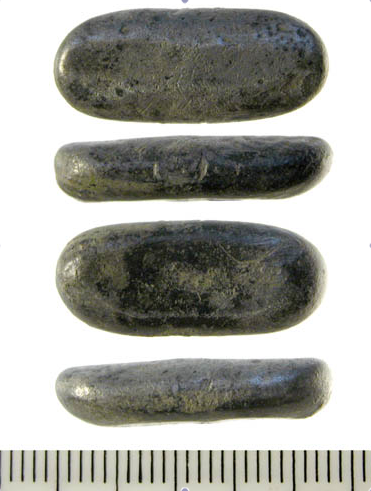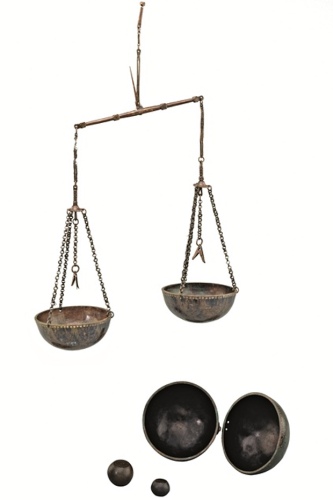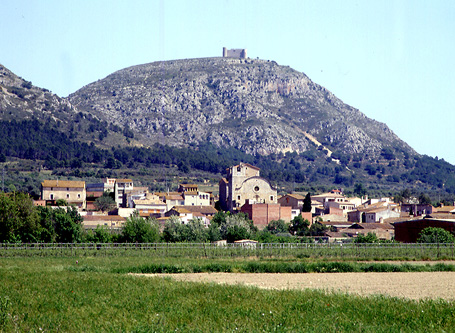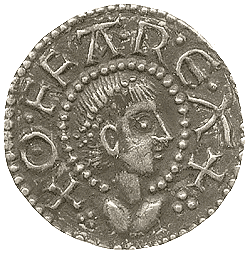Sing hallelujah, for I have brought my seminar reporting backlog under a year again at last! Witness: the date of the seminar involved in this post is 13th January 2015, when my old colleague and Viking metal expert Jane Kershaw came to Birmingham to tell the Research Seminar of the Centre for the Study of the Middle Ages about “The Bullion Economy of Viking England”, and I was there.

Part of the classic example of hack metal from the British Isles, the Cuerdale Hoard, on display at South Ribble Museum
The starting premise here is a duality long accepted by scholars of early medieval Scandinavia between monetary economies, where value can be measured, stored and exchanged in coin that is guaranteed to some extent by an outside agency like the state, and a bullion economy in which precious metal (or other metal) is dealt with by weight to perform the same functions. This is a concern of Scandinavianists because Viking Age Scandinavia operated on the latter terms whereas the places it was preying on usually had money, so whereas a ninth-century hoard in, say, the Paris basin would usually be coins, a ninth-century hoard in Sweden is classically many many Samanid dirhams, coins yes but often cut into non-arithmetic fragments, along with bits of jewellery, ingots and other lumps and bits of cut-up metal, or hacksilver as it’s usually called. Even the intact coins in such a hoard will very often bear peck marks from where their metal content was not taken on trust but tested with a knife-point or similar.

Reverse of a penny of King Æthelred II of England showing ‘peck’ marks in the upper right quarter. The coin is in the Fitzwilliam Museum, Cambridge
Now of course, sometimes you get ‘Viking’ hoards in ‘victim’ areas, and this is especially the case in the areas of England that were subject to Viking settlement. But these were money-using areas, so what happened when people who worked a different way moved in? This was the subject of Jane’s paper, because while hoards have told us mainly that settlers seem quickly to have adopted coin, to the point of making their own proper-standard stuff in the name of locally-culted saints, the single-finds that are continually being recovered by metal-detector users these days, the bits and pieces that people dropped or lost and which therefore presumably represent the everyday better than an emergency deposit like a hoard, tell a different story, because what they dropped and lost looks much more like the kind of cut-up bullion we expect from a non-monetary situation. In other words, people were doing both.

A cut fragment of a silver Permian ring from a Viking context and now in the Fitzwilliam Museum; photograph by Jane Kershaw
To an extent, this shouldn’t surprise us, as several people opined in questions. When your smallest available monetary unit is a penny cut in half or quarter, quite a rare thing to find but still in the realm of, say, five or ten pounds sterling as of 2015—total fudge figures because we can buy so much more and get money so much more easily, but an approximation for thinking with—some smaller ways of handling value must have been desirable, for the basic everyday level of exchange that we mostly can’t see but assume was usually done with produce. But Jane gave us two other important things to consider.

A smooth, ‘regular’ ingot with rounded ends and test marks (PAS ‘Find-ID’ SF-144CA2, photo: PAS), says Jane on her blog
Firstly, many of the lumps of metal we find are much bigger than this, including ingots of around 50 grams, with a buying power on the same scale of more like three to five hundred pounds. So the bullion economy could supplement the top end of the monetary one as well as the bottom one, and perhaps better since really tiny pieces of silver and gold such as might make for low denomination currency would be awfully easy to lose!

Viking copper alloy collapsible weights from 1000-1200. Photograph by Klaus Göken/Museum für Vor- und Frühgeschichte/Berlin State Museums.
Secondly, operating in a bullion economy requires learned skills that a monetary one displaces: you as trader, on whatever scale, need to be able to weigh, test, evaluate and value all kinds of metal object or fragment to be sure that you are receiving what you think fair and paying no more than you have to. Coin which you can trust gets rid of those problems and leaves you only haggling over a fair price, without needing to work out how to express that, demand it or ensure that you’ve really received it. Small wonder that many graves of people from this period with strong Scandinavian connections include small sets of weights and balances!

A carefully-sorted assemblage of finds from Torksey, Lincolnshire, in the Fitzwilliam Museum, Cambridge. Obviously they didn’t come in looking as tidy as this!
This all sounds somewhat chaotic, and assemblages like the above, pulled together from twenty-five years of metal detecting over the area of a short-lived Viking fortified harbour, tend to corroborate that impression: how could anyone manage all this stuff? Well, among all the stuff above that seemed clear and sensible and somewhat like someone pointing out the floor under a carpet I had got very used to walking on, Jane also had some hints of a system being used to manage the chaos, by possibly setting weight standards in some metals. The hints here are cubo-octohedral weights, square lumps with the corners cut off, which are found in various sizes from just above a gram to just below four, and are numbered with spots, like dice with only one face. They are found numbered all the way from one to six, and their weights are roughly in proportion to those numbers but so far no example has been found with five spots.

A number four weight of the type Jane was discussing, photographed by her and discussed on her blog (click through)
It’s hard not to see a system there, and Allan McKinley bravely suggested that a dirham might be about the right weight to be the five-spot unit, though I checked this later and dirhams seem usually to have been too heavy. But the problem is variation and regulation: the weights aren’t exactly consistent, and how could they be? What reference could there have been except someone else’s weights? That need not preclude an aim to be consistent, but it makes it impossible for us to verify: the error margins of the weights of something so small could very easily exceed a step in the scheme. If a high-weight two-spot one weighs more than someone else’s light three-spot one, we have to ask not only how could this work but how can we be sure they really should be the other way round? I’m not saying Jane’s not right about this, but early medieval metrology is notoriously unverifiable except by constructing models that then guide your sense of what the objects ‘should’ weigh, and given that, I’m not sure what she will have to do to convince me we can really know that one of the models is sustainable…
Jane’s cite for the bullion economy system was Dagfinn Skre (ed.), Means of exchange dealing with silver in the Viking Age, Norske Oldfunn 23 (Århus 2008), and it’s a good one, though I feel that we have to mention Mark Blackburn, Viking Coinage and Currency in the British Isles, British Numismatic Society Special Publication 7 (London 2011) too; for more local examples, see now Jane Kershaw, “Viking-Age Silver in North-West England: hoards and single finds” in Stephen E. Harding, David Griffiths & Elizabeth Royles (edd.), In Search of Vikings: Interdisciplinary Approaches to the Scandinavian Heritage of North-West England (Florence KY 2014), pp. 149-164.




